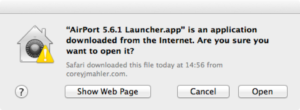Launcher for AirPort Utility v5.6.1
If you find the Launcher posted anywhere else, let us know!
What is Bristlecone IT Services?
Bristlecone IT Services is an IT services company that serves clients of all sizes, from individual computer users to multinational corporations.
I thought I was on CoreyJMahler.com!
These files were originally created by Corey J. Mahler, and he is the owner of BITS. The files were moved over to ZCS in June of 2016 when Mr. Mahler redesigned his website and ZCS was renamed to BITS in 2018. The Launcher is now maintained by BITS.
AirPort Utility v5.6.1
for
- OS X 10.7 “Lion”
- OS X 10.8 “Mountain Lion”
- OS X 10.9 “Mavericks”
- OS X 10.10 “Yosemite”
- OS X 10.11 “El Capitan”
- macOS 10.12 “Sierra”
- macOS 10.13 “High Sierra”
- macOS 10.14 “Mojave”
- macOS 10.15 “Catalina”
Support Our Freeware!
123 Main St
Anytown, CA 90001
and
213-555-1234
What the Launcher Is, What the Launcher Does, and Why It Exists
The Launcher is a small utility for OS X (compatible versions listed, supra). Using the Launcher, it is possible to run AirPort Utility v5.6.1 under versions of OS X that would otherwise reject the application. This older version of AirPort Utility is needed to configure older AirPort units (both AirPort Express and AirPort Extreme). For whatever reason, Apple updated AirPort Utility and the new version does not support older AirPort units; obviously, this presents a problem for people who still own these older units.
Everything the Launcher does can be accomplished through Terminal (access to a machine running OS X 10.6 Snow Leopard is also required). The details of how to do this are included, infra.
How the Launcher Does What It Does
With the release of OS X 10.9 “Mavericks” Apple updated file Apple80211 (contained in /System/Library/PrivateFrameworks/Apple80211.framework/Versions/A). Whatever the other effects of this update, it broke backwards compatibility with older versions of AirPort Utility. Thankfully, the fix is simple: Inject an older version of the file when launching older versions of AirPort Utility. This is precisely what the Launcher does.
When you run the Launcher, it simply injects the OS X 10.8 “Mountain Lion” version of file Apple80211 (which the Launcher contains) and then runs AirPort Utility 5.6.1 (which is included in the download of the Launcher). That’s it. One file is the difference between AirPort Utility 5.6.1 running and throwing an error under more recent versions of OS X.
Downloads
Whereas BITS does have several software development projects, and some of these are licensed Apple Developers, this software is offered as is and is in no way authorized by, approved by, or in any other way recognized by Apple Inc. or any of its subsidiaries. While we have no reason to believe that any harm will come from using this software, we offer it without warranty, guarantee, or any other representations of any kind. By downloading the Launcher from this site, you agree to the foregoing and further agree to hold Bristlecone IT Services (“BITS”) and its subsidiaries, owners, members, employees, and any other personnel wholly harmless in connection with your use of the software.
Troubleshooting
FAQ
Why not use a single application? / Why use a companion application?
How do I link the Launcher on the Apple Support Communities? / Why did Apple remove my link from the Apple Support Communities?
Any links to this article will be removed by Apple staff.
Can the Launcher be used/updated to make an older version of X run under a newer version of OS X?
How can I get AirPort Utility v5.6.1 working without the Launcher?
- Rename the new Apple80211 file (i.e., the one included in newer versions of OS X) to Apple80211.new (or anything but what it is currently named, actually).
- Place the old version of the Apple80211 file into the /System/Library/PrivateFrameworks/Apple80211.framework/Versions/A directory.
- Open Terminal and do the following: Navigate to the directory in which you have AirPort Utility v5.6.1, navigate into the .app, navigate to Contents/MacOS; once in the MacOS directory, you will see a file called “AirPort Utility”, type the following: “./AirPortUtility” (without quotes).
Do you offer support?
Common Issues
Unidentified Developer Warning

The Launcher is unsigned. If you double-click to open the Launcher, you will likely receive an error. To avoid this error, simply right-click on the Launcher and then click “Open” instead of double-clicking.
AppTranslocation Error under macOS 10.12 Sierra (or Later)
- re-download the *.dmg or the *.zip,
- open the file after download,
- and then move the two *.app files inside the resulting “AirPort Utility 5.6.1” folder one at a time to a folder on your hard drive (the Utilities folder in Applications is the recommended location for obvious reasons).
That’s it. The Launcher should continue to work for you under macOS 10.12 Sierra (and this fix is a one-time necessity).
macOS 10.15 Catalina (or Later)
xattr -d com.apple.quarantine [path to Launcher.app here]
xattr -d com.apple.quarantine [path to AirPort Utility 5.6.1.app here]
You must replace the bit in brackets with the actual paths to, respectively, the Launcher and AirPort Utility 5.6.1. Do not worry about typing the two paths, simply drag the Launcher (make sure the space after “quarantine” is maintained) and drop it into Terminal and macOS will fill in the path for you (the same is true of AirPort Utility 5.6.1).
